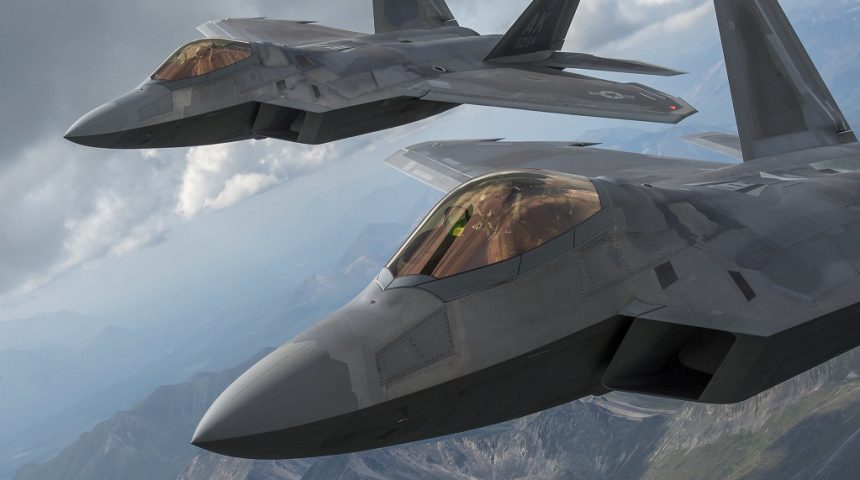The fighters trained together to start the celebration week for the 100th anniversary of the 3rd Wing.
On July 18, 2019, F-22 Raptors assigned to the 90th Fighter Squadron from Joint Base Elmendorf-Richardson (JBER) and F-16 Fighting Falcons assigned to the 18th Aggressor Squadron from Eielson Air Force Base teamed up for a training flight over the Joint Pacific Alaska Range Complex, in anticipation for this week’s celebrations for the 100th anniversary of JBER’s 3rd Wing, which occurred on July 1.
The flying component of the Wing, the 3rd Operations Group, is a direct descendant of one of the 15 original combat groups created by the U.S. Army Air Service before World War II. The 3rd Wing is also known for giving birth to exercise Cope Thunder, which later evolved in today’s Red Flag-Alaska.
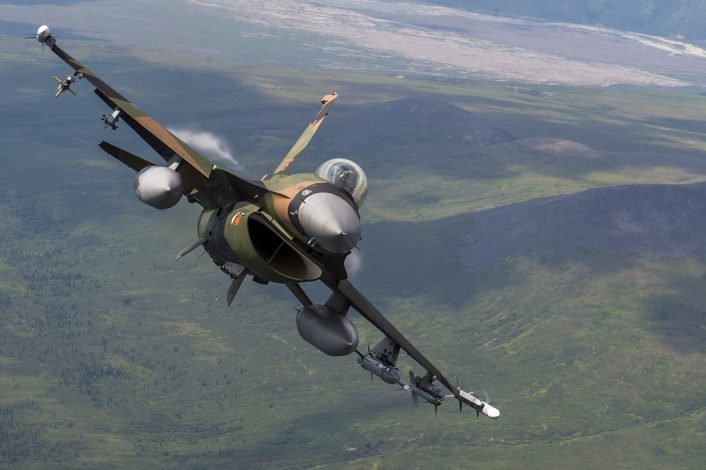
The 3rd Wing’s lineage originated July 1, 1919 as an Army Surveillance Group out of Kelly Field (Texas) flying British-designed, American-made DeHavilland DH.4 aircraft to patrol the U.S.-Mexico border during the Mexican Revolution. After WWI the unit became the 3rd Attack Group, focusing on aerial experimentation and pioneering dive bombing, skip-bombing, and parafrag attacks that were later employed by U.S. Army Air Corps/Forces bomber squadrons during World War II.
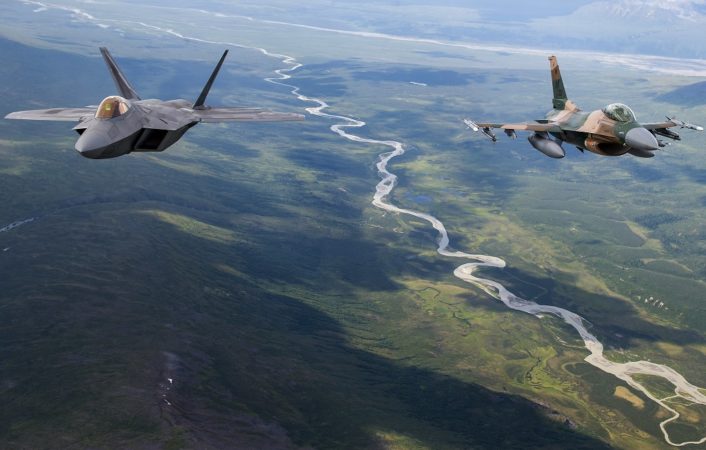
Following the infamous attacks on Pearl Harbor, the 3rd Attack Group started combat operations against Japan. In 1942, after changing name to 3rd Bombardment Group, the unit received new bombers and helped developing low-altitude strafing tactics, becoming famous for their combat proficiency.
In 1950 the group, after assuming the Wing designation, was tasked to provide the Korean War’s first bombing mission. Notably, a B-26 gunner from the 3rd Wing scored the first aerial victory of the war, shooting down a North Korean YAK-3.
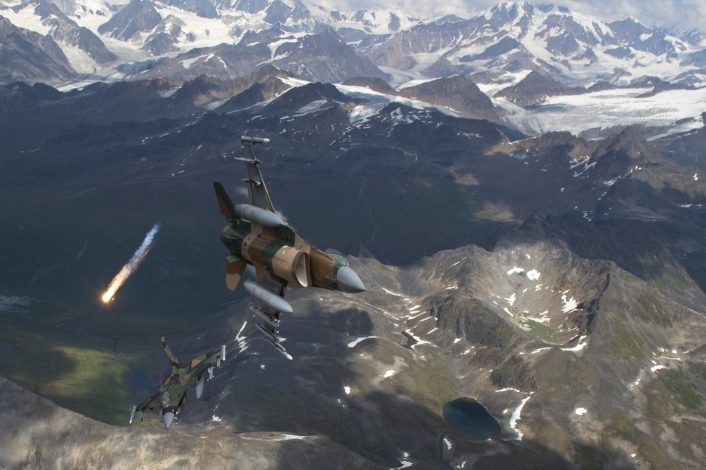
After being re-designated as the 3rd Tactical Fighter Wing in 1964, the unit moved to England Air Force Base, Louisiana, and started training in preparation for the Vietnam War. The 3rd Wing flew its B-57 Canberras and F-100 Super Sabres from different air bases all over South-East Asia, totaling more than 200’000 combat sorties.
During the war, the Air Force selected the 3rd TFW to evaluate the new F-5 Tiger in real operations, flying over 2,600 combat missions from October 1966 to March 1967 and resulting in several modifications that helped to improve the aircraft capabilities.
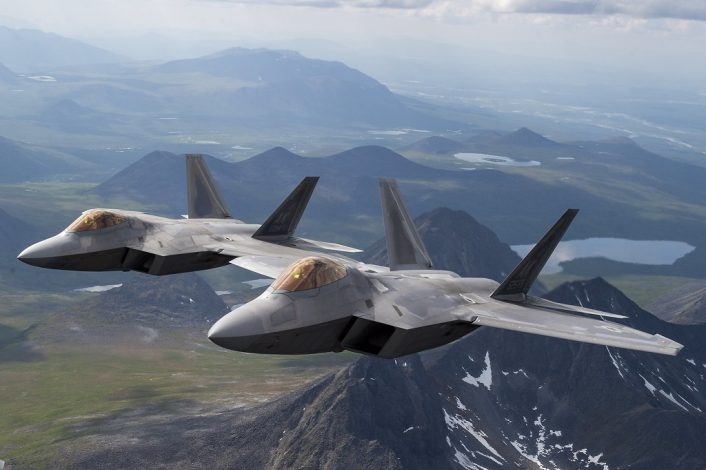
At the end of the Vietnam War, the 3rd TWF, equipped with F-4E Phantoms, relocated to Clark Air Base in the Philippines where it received also F-5E Tigers as aggressor aircrafts and started hosting exercise Cope Thunder since 1976. The exercise was initiated by Brigadier General Richard G. Head and was intended to give aircrews from across Asia their first taste of combat in a realistic simulated combat environment, improving U.S. and international forces joint combat readiness. Analysis at the time indicated most combat losses occurred during an aircrew’s first 8 to 10 missions, hence the goal of Cope Thunder was to provide each aircrew with these first missions, increasing their chances of survival in real combat environments. The exercise quickly grew into PACAF’s (PACific Air Forces) “premier simulated combat airpower employment exercise.”
Cope Thunder was moved to Eielson AFB, Alaska, in 1992, after a volcanic eruption heavily damaged Clark AFB. Eielson Air Force Base was considered the most logical choice because of the presence of three major military flight training ranges in nearby. The move helped the exercise’s evolution until, in 2006 Cope Thunder changed name to become Red Flag-Alaska, one of the most important exercises hosted by the U.S. Air Force and held four times a year.
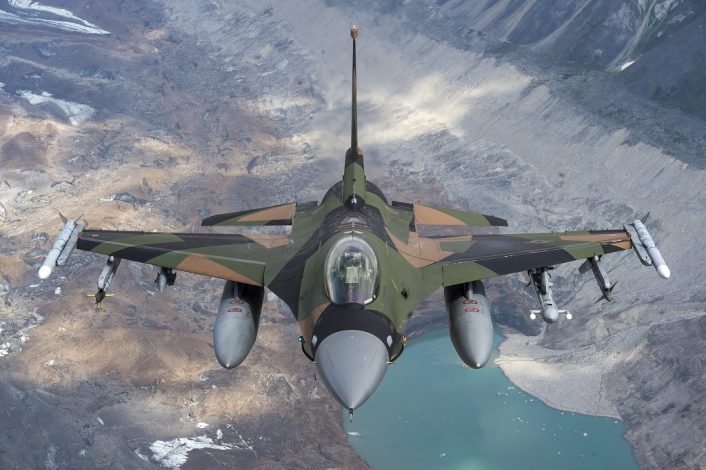
The 3rd TFW, now designated 3rd Wing, instead relocated to the nearby Elmendorf AFB and acquired two squadrons of F-15 Eagles, one squadron of F-15E Strike Eagles, one squadron of C-130s and a squadron of E-3 AWACS.
In 2007 the Wing replaced its F-15s with F-22s, becoming the second USAF air base, and the first of PACAF command, to host operational F-22 Raptor squadrons. F-22s regularly launch from Quick Reaction Alert cells at Joint Base Elmendorf-Richardson to intercept Russian bombers flying close to Alaskan airspace.
Since the move to Alaska, the wing has successfully participated in all major U.S. operations from Desert Storm to the most recent Inherent Resolve.
Interestingly, one of the Aggressor F-16 was painted in a livery unveiled in 2017 and dubbed “BDU Splinter”, mimicking colors seen in both the Cold War era “European One” and the Vietnam era Southeast Asia camouflage schemes. The full album is available on the Flickr page of Joint Base Elmendorf-Richardson.

